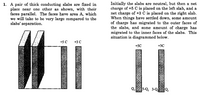
Introductory Circuit Analysis (13th Edition)
13th Edition
ISBN: 9780133923605
Author: Robert L. Boylestad
Publisher: PEARSON
expand_more
expand_more
format_list_bulleted
Concept explainers
Question
please answer d and e

Transcribed Image Text:1. A pair of thick conducting slabs are fixed in
place near one other as shown, with their
faces parallel. The faces have area A, which
we will take to be very large compared to the
slabs' separation.
Initially the slabs are neutral, but then a net
charge of +5 C is placed on the left slab, and a
net charge of +3 C is placed on the right slab.
When things have settled down, some amount
of charge has migrated to the outer faces of
the slabs, and some amount of charge has
migrated to the inner faces of the slabs. This
situation is diagrammed below.
+5C
+3 C
+5C
+3C
5-Q, 3-Q

Transcribed Image Text:Notice that the charges on the loft slab add up
to +5 C as required by charge conservation-
and likewise for the right slab. Notice also
that, in accordance with the rules for
conductors, all charges reside on the surfaces
of the conductors. The goal of this question
will be to use other rules for conductors to
determine the unknown charges Qi and Qa.
c) Repeat parts (a) and (b) for the right slab, i
order to find Qu.
d) What are the charges on the inner surfaces
the slabs?
e) You should have found that the charges on th.
inner surfaces of the slabs are equal an
opposite. This will be true regardless of how
much charge is on either slab. Can you prov
this by drawing an appropriate Gaussia
surface and making use of the fact that th
field in either slab vanishes? •
a) Treating Qi and Qa as known quantities, use
superposition to find an expression for the
electric field within the left slab.
b) Taking into account the fact that the slab is a
conductor, use this expression to find Q.
Expert Solution
This question has been solved!
Explore an expertly crafted, step-by-step solution for a thorough understanding of key concepts.
This is a popular solution
Trending nowThis is a popular solution!
Step by stepSolved in 3 steps with 2 images

Knowledge Booster
Learn more about
Need a deep-dive on the concept behind this application? Look no further. Learn more about this topic, electrical-engineering and related others by exploring similar questions and additional content below.Similar questions
- For the following circuit answer the question bellow: a b ve c darrow_forwardAnswer only typing format solution please Thanks for the informationarrow_forwardThere are TWO pictures, 1 for the question and 1 for the answer choices. Answer correctly with all work shown with correct units for a Please answer in typing format pleasearrow_forward
arrow_back_ios
arrow_forward_ios
Recommended textbooks for you
 Introductory Circuit Analysis (13th Edition)Electrical EngineeringISBN:9780133923605Author:Robert L. BoylestadPublisher:PEARSON
Introductory Circuit Analysis (13th Edition)Electrical EngineeringISBN:9780133923605Author:Robert L. BoylestadPublisher:PEARSON Delmar's Standard Textbook Of ElectricityElectrical EngineeringISBN:9781337900348Author:Stephen L. HermanPublisher:Cengage Learning
Delmar's Standard Textbook Of ElectricityElectrical EngineeringISBN:9781337900348Author:Stephen L. HermanPublisher:Cengage Learning Programmable Logic ControllersElectrical EngineeringISBN:9780073373843Author:Frank D. PetruzellaPublisher:McGraw-Hill Education
Programmable Logic ControllersElectrical EngineeringISBN:9780073373843Author:Frank D. PetruzellaPublisher:McGraw-Hill Education Fundamentals of Electric CircuitsElectrical EngineeringISBN:9780078028229Author:Charles K Alexander, Matthew SadikuPublisher:McGraw-Hill Education
Fundamentals of Electric CircuitsElectrical EngineeringISBN:9780078028229Author:Charles K Alexander, Matthew SadikuPublisher:McGraw-Hill Education Electric Circuits. (11th Edition)Electrical EngineeringISBN:9780134746968Author:James W. Nilsson, Susan RiedelPublisher:PEARSON
Electric Circuits. (11th Edition)Electrical EngineeringISBN:9780134746968Author:James W. Nilsson, Susan RiedelPublisher:PEARSON Engineering ElectromagneticsElectrical EngineeringISBN:9780078028151Author:Hayt, William H. (william Hart), Jr, BUCK, John A.Publisher:Mcgraw-hill Education,
Engineering ElectromagneticsElectrical EngineeringISBN:9780078028151Author:Hayt, William H. (william Hart), Jr, BUCK, John A.Publisher:Mcgraw-hill Education,

Introductory Circuit Analysis (13th Edition)
Electrical Engineering
ISBN:9780133923605
Author:Robert L. Boylestad
Publisher:PEARSON

Delmar's Standard Textbook Of Electricity
Electrical Engineering
ISBN:9781337900348
Author:Stephen L. Herman
Publisher:Cengage Learning

Programmable Logic Controllers
Electrical Engineering
ISBN:9780073373843
Author:Frank D. Petruzella
Publisher:McGraw-Hill Education

Fundamentals of Electric Circuits
Electrical Engineering
ISBN:9780078028229
Author:Charles K Alexander, Matthew Sadiku
Publisher:McGraw-Hill Education

Electric Circuits. (11th Edition)
Electrical Engineering
ISBN:9780134746968
Author:James W. Nilsson, Susan Riedel
Publisher:PEARSON

Engineering Electromagnetics
Electrical Engineering
ISBN:9780078028151
Author:Hayt, William H. (william Hart), Jr, BUCK, John A.
Publisher:Mcgraw-hill Education,